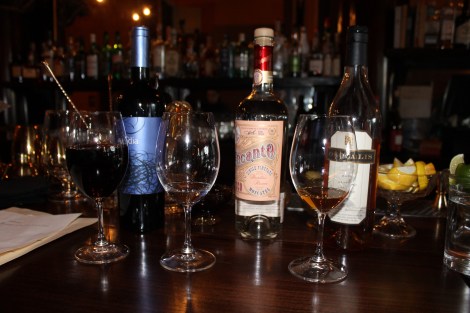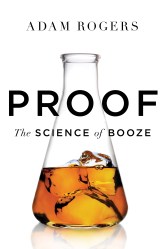I’d always thought of booze as something that was trying to kill me in the most unnatural way possible. So reading Adam Rogers’ new book Proof: The Science of Booze was like meeting a bully from high school and finding out that he’s really a sweet, misunderstood guy. Rogers shows, again and again, that booze is actually a high form of cooperation between human technology and nature.
I asked the author to meet me at one of his favorite bars and explain how drinking connects us to the natural world. He told me to meet him at Handlebar, a place in Berkeley with a massive wooden bar, muted lighting, and tinkling music. (I’ve edited and condensed our talk.)
Q. I thought I’d just ask you to recommend a drink and tell me all the different ways it links us to the natural world. But you should know: I’ve become a lightweight since I had kids.
A. Maybe we should drink through the process of production. Here’s what we’re going to do: we’ll get a glass of wine — they don’t have grape juice to start with, which is a shame because it’s a good substrate. But wine, then pisco — which is distilled wine. Then brandy from a distillery called Osocalis in the mountains above Santa Cruz, run by a former scientist, very nice guy. And then an old fashioned, which is in some respects a model for the earliest kind of cocktail, because all it is booze, sugar, and bitters.
Q. Is this a historical progression as well?
A. There’s the progress of the way human beings learned to make this stuff. And also the process of one thing turning into another. This also became the organizational structure for the book. It walks you through this process and pivots on the moment a bartender puts something like that brandy in front of someone like you. That moment — to be super hyperbolic about it — is when 20 million years of evolution, 10,000 years of work on fermentation, 2,000 years of work on distillation, all come down to whatever is in that glass in front of you.
When you take a sip, all that history and science and interaction of species gets filtered through your ability to isolate all the other sensory inputs around you and smell and taste and feel what you are drinking. And then, the effect that it has on your body, which is a way we connect to the natural world.
These things in front of us aren’t all made from the same grape, but they are essentially the same thing. If you start with grape juice, that’s the sugar source. You ferment that, give it to yeast; they eat the sugar, excrete carbon dioxide and ethanol, and you end up with this — wine. And that metabolism is actually much more complicated, it produces a lot of other chemicals, too.
Q. Which is what makes wine so fabulous.
A. Exactly. And grapes are eminently suited to that process. There are a lot of molecules in grapes that yeasts are good at putting together. But it’s possible that we just think that because grapes happened to be around in the Fertile Crescent. As one researcher said to me, if we evolved on a Pacific island, it would be coconuts, and grapes would be an afterthought. But grapes are what you get, so you get to taste it. That’s really good.
Q. That does taste good. Wasn’t one of your points that yeast like to live on grape skins, so if you have grapes, you probably have wine?
A. Yeah. It’s hard not to have it ferment. Now, if it’s just ambient microbes in the air, it’s probably not going to taste that good. They’re not the ones that have been tuned over thousands of years to make wine. Same issue with some breads, same issue with sausage, any fermented product.
Fermentation is a natural process — if a grape falls in a forest and no human is there to drink it, it still turns into ethanol. Distillation is different. Distillation is a human technology. It takes smart monkeys with wrinkled frontal cortexes and opposable thumbs. I try to celebrate that in the book: We bring something new. We make stuff. We work with tools better than any other animal.
The story that I like says that distilling grows out of the very beginnings of science in ancient Alexandria. The beginnings of when humans were starting to say, we can think about our universe differently — we can say, I want to understand why something happens, and I can apply a method that will give me answers. That’s really kind of wonderfully hubristic — the idea that we can figure something out.
Q. It’s not just the realm of the gods.
A. Or, another way to think about it is, we can apprehend the realm of the gods. Sure the gods did it, but we can figure it out. Which is beautiful.
So you build a still. It takes 900 years before anyone thinks to put wine in a still, in China, or maybe Russia. But you end up with something like pisco. Pisco is distilled wine — it’s an unaged brandy, it originates from South America.
Q. Hiiiyach! Yow.
A. Yeah, that’s fiery, and there are going to be things behind this bar with a much higher alcohol content. The thing that’s interesting to me is if you take a sip of wine, then take a sip of pisco, you go, oh, OK, there are some similarities.
Q. OK, I have to do this again, because I didn’t get that. It might just be the overwhelming burn.
A. I think at least in the character of the sweetness.
Q. Yeah, I taste that. In the pisco the flavors are more like overtones almost.
A. Pisco is meant to be a pretty rough-hewn spirit. It’s a peasant fire water. And that’s a category of distillates that I love, but they are rough, man. Nobody ever meant them to be sipped, except in a cocktail like the pisco sour.
So you ferment it, then you distill it. Next, you age it.
Q. I see: you have nature doing its biology, then humans coming along and applying technology …
A. … and then an additive technology, that probably comes from just attempting to store it, for trade. You put it in a barrel, and the wood begins to contribute to the flavor. Long about the 1820s, the rules about how much time it needs to stay in a barrel begin to be codified, because there’s a lot of ways to fake that. When cowboys in the old West walked into a bar and ordered a whisky, that was as likely to be a white whisky as it was to have been aged. And the aging just came from the long trip in a barrel from Kentucky to the Nevada Territory.
Q. And white whisky is the equivalent of pisco?
A. Right, white whisky is distilled beer. Everything that comes out of a still is clear; none of the pigments make it over the top. And when you put that clear stuff in a barrel, ethanol, which is a very good solvent, extracts that color from the wood. So you go from a pisco to brandy like this Oscallis.
Ah, it’s really, really nice.
Q. Brandy is pisco with bits of wood in it?
A. At a molecular level, yeah. And in addition to the colors, it’s bringing in all kinds of molecules from the wood. Now, barrel making is its own type of technology. Changing the shape of wood is really hard. If you add heat and steam, wood will become thermoplastic — it will bend. And you have to be able to cut the wood with two different bevels, so that when you bend it and bring these staves together they fit into this barrel shape — it’s like unblooming a flower.
Q. Unblooming — I love that. And it’s watertight.
A. But only if you cut the wood the right way — if you quarter saw the wood. Otherwise, there are pores. You can imagine the experimentation that had to go into figuring out how to do all that. Typically it’s oak, though some Americans are experimenting with other kinds of wood. Hickory lends a kind of barbeque flavor, maple adds some sweetness.
Q. There’s a connection to another species there, the tree.
A. That’s right — and not just the tree, a connection to even more microbes. If you kiln-dry the wood you use to make a barrel, it actually changes the flavor. What wine makers have done for centuries is to use air-dried wood, wood that sits outside and weathers for up to three years. And when that happens, it’s being exposed to a whole suite of other microbes. Nobody has done a lot of good research on what those are. We know you get different flavors, but it’s just a connection to another undiscovered world.
Q. This, by the way, is amazing brandy.
A. He is so good at making brandy. And he’ll say that brandies don’t start coming into their own until they’ve been sitting in a barrel for 20 or 30 years. Because there’s an additional chemical process: Besides the extractives that come out of the barrel — the oak lactones that taste like coconut and lend mouth feel, plus a whole bunch of other chemicals that are still being identified — time contributes its own flavors. Oxygen gets added to the molecules; acids and alcohol molecules combine to form esters. There’s a slow, almost ineffable mixing of chemical processes. People talk about smooth drinking: smoothness is what you get from time.
That brings us to economics. Because, in order to decide to keep a barrel in a warehouse 20 years before selling it, you need credit, and you need real estate, and you need an upper class that can afford it. A whole other kind of civilization has to develop to accommodate a bottle of 18-year old whiskey.
Q. The kind we like to call “advanced” …
A. Hah, I don’t know if it’s advanced or even good, but it’s what we have. And all those steps in this process, I would still argue, are all connections to the natural world.
Sugar is a connection to this particular molecule that nature uses again and again because it’s both structural and contains a lot of energy — an amazing way the universe has organized itself. Yeast is a connection to domesticating the world around us, and how the world around us domesticates us. Distillation is us trying to effect change on that natural world — you have to be able to work with metal, you have to work with heat, you have to understand what steam is — you have to learn a lot about the natural world to make that work. For aging, you have to develop an economy, you have to develop trade, you have to realize that your field full of vines is worth more condensed down to brandy than it is as grapes.
I don’t know what happened to the old fashioned. Perhaps we drank that too? Was that before or after we began talking about and sampling the Chartreuse? Things get hazy here. For any more, you’ll have to read the book.




